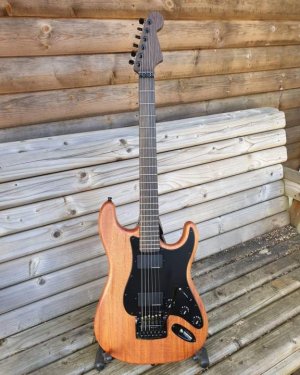I think the thread title needs to be updated: How did you choose your guitars
My first guitar was a Sears strat, because that's all I could afford on paper route money and my parents weren't going to help me. (In fact, they were pretty hostile to my music, despite both of them being musicians.). The guitar was terrible. Didn't quite play in tune, didn't make the sounds of the records I was copying. (Didn't have a 'real' amp at the time either.). But I went with it because I was learning. It was more important to figure out how to play songs at the time.
After a few years, I landed a spot in an orchestra supporting a live stage play that was touring. Then my parents bought me a G&L F100 and a Randall RG-80. That worked, but while out on the road I met some session musicians and they let me play their rigs and they played mine. They pointed out the issues, like single notes on the plain strings weren't nearly as thick as the wound strings, etc. I kept that in mind, but no way had the money to get the rigs they were proposing (ES335 through a Fender Twin with a Tube Screamer, etc.)
Next guitar I bought was a Yamaha shred stick. I had already figured out a Strat body was the most comfortable/ergonomic, I just needed one that made all the sounds I wanted. I went Yamaha because Alex Lifeson was getting sounds I wanted at the time with a similar configuration guitar, and I set a limit of $300, I would never buy anything more than $300. At the time I thought I don't need $1000+ guitars because I believed I could find something that could make the sound I wanted at the price I could afford. The one I bought had active electronics (which was a thing at the time) and it was clean, and did all the music I needed to do at the time.
After getting some studio work, and talking with engineers, they pointed out additional issues with the rig I was using, demonstrating the difference when it's mic'd up, run through a board, played back from a track. (You don't really hear yourself until you hear yourself played back while passively listening.). They were right in that last 10% of difference is in almost half the cost of getting the right tool for the job.
I determined I needed to find a way to get the right guitar and right amp for the sounds I really wanted to make, which turns out was a Gibson Les Paul into a Marshall 100w 4x12 situation. LIke the engineers pointed out to me, a lot of records were made with that combo - more than you realize, even country hits. In 1994 I went out and bought a Gibson Les Paul Standard, and shortly thereafter a Marshall SL-X half stack with Tesla EL-34s (still have them and play them to this day - see my avatar. With the Teslas, man it sounded exactly like Angus). It took me 3 years to pay off the guitar.
I almost bought a Gibson Explorer, black/white guard with uncovered pickups. It was hands down THE best sounding Gibson on the wall, but it had a loud 60hz ground buzz, which at the time I did not know anything about how to fix in a guitar and didn't want to pay that much on a new guitar to have to have it repaired just to play it. That drove me back to the Les Pauls, and all the ones on the wall were bright pink or blue or purple quilted, which wasn't my style I couldn't be seen holding at the time, but there was just one on that wall that was just a sedate normal dark honeyburst. The guy helping me pointed out that the 'exact' same original honeyburst model from 1959 was hanging up over on the other wall, priced at $120,000, which was the price of a house at the time. He noted while the value goes down for the first 5-10 years as used, after 20 years or so the value starts going back up, so if you hold onto it, you won't lose your money. So that's still my #1; one owner, original owner guitar.



